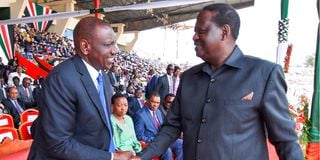‘Why Raila lost’ was a story that required more and hard sources

President William Ruto with former Prime Minister Raila Odinga at Nyayo National Stadium during a past Jamhuri Day celebration. Mr Odinga lost to Dr Ruto, the UDA candidate in the Kenya Kwanza coalition.
As a general rule, the more sources a journalist employs in a story, the better. And, as the Reuters Foundation Reporters handbook says, “the bigger the story the more essential it is to have hard, named sources”. NTV’s “Why Raila Lost”, a 32:52-minute controversial feature story screened on Monday night, could have been improved with the application of this rule.
“Why Raila Lost” was touted as “an in-depth look on why Raila lost to William Ruto in August.” But viewers were treated to what turned out to be monologues of vicious tongue-lashing, rantings and bizarre statements by three of what one might call the “bad boys” of Azimio. But it was an otherwise revealing story.
If, despite the title, the purpose of the feature was to provide insights into the thinking of the bad boys, the story would be considered to be terribly effective. It wouldn’t need “more and hard sources”.
The story generated debate that attracted more than 400 social media comments, more than 130 of them on YouTube where the documentary, titled “Why Raila Odinga lost 2022 election”, has been posted.
Additionally, the story is exclusive to NTV. Other media had to report the story as second-hand. Kennedy Murithi, the NTV senior political reporter who scooped the competition, has earned the bragging rights.
The visual performance starring Embakasi East MP Babu Owino, Azimio’s chief agent in the August presidential election Saitabao Ole Kanchory, and Jubilee Party secretary-general Jeremiah Kioni, is great theatre. The story, as aired, was indeed a gift to the threesome. They advanced their agenda, unchecked and unmoderated by the NTV interviewer.
Example: Babu Owino says in his unbridled monologue that he called Interior Principal Secretary Karanja Kibicho. “I told Kibicho the way things were moving we need to act very fast. He asked me back, ‘What do we do?’ I told Kibicho we needed to arrest [IEBC chair Wafula] Chebukati immediately for bungling the election. Do you know what Kibicho told me? ‘Wacha vita, wacha vita!’ Hey! Nikasema what’s happening na huyu mtu. Was he part of this? I’m telling you the truth. This man was supposed to be our person but what’s happening? Wacha hii, wacha vita (Owino makes fun of Kibicho, laughing and gesticulating). Nikamwambia no, it’s for you to arrest Chebukati for bungling what? Election. Then [deputy chair Juliana] Cherera to announce that Baba has won, as the winner, you see. Or we go for eh, eh… (NTV interviewer completes the sentence with ‘rerun’). Rerun because the election is already being bungled.”
Kanchory and Kioni also tell fantastic but unsubstantiated stories, which make the documentary highly polemical. And the public reaction showed people haven’t moved on from the August election obsession.
“Why Raila Lost” was published four months after the official declaration of the results and almost three months after “How Raila lost”, an in-depth analysis published by the Daily Nation on September 21, 2022.
“Why Raila Lost” didn’t build on “How Raila lost,” as one might have expected. It just created new controversies. The story is in want of more and hard sources as well as a good measure of skepticism on the part of the NTV reporter.
The story doesn’t deliver an “in-depth look” and it should be more accurately titled “Key Azimio figures disagree on why Raila lost” (or words to that effect). It’s a hotchpotch of controversies in which the reporter seems to be a passive messenger. For example, he did not ask Kioni to name the polling station in Nyeri, which he claimed gave William Ruto 400 votes belonging to Raila Odinga.
And everyone seems to have forgotten the simple and basic fact on which to hang the story: More people voted for William Ruto, as confirmed by the Supreme Court. The rest is polemics.
The reporter short-changed viewers by confining himself to the polemics. He could have served viewers better by seeking more voices, including those of pundits, to give a more balanced and comprehensive view. A reporter’s duty to his audience is to give the facts from all sides, as far as possible, and not to allow them to be captives — in this case — of the self-glorifying bad boys of Azimio.
The Public Editor is an independent news ombudsman who handles readers’ complaints on editorial matters including accuracy and journalistic standards. Email: [email protected]. Call or text 0721989264





